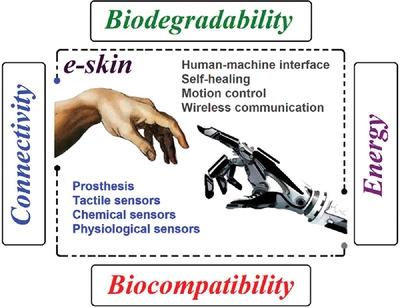当前位置:
X-MOL 学术
›
Adv. Mater.
›
论文详情
Our official English website, www.x-mol.net, welcomes your
feedback! (Note: you will need to create a separate account there.)
Advances in Biodegradable Electronic Skin: Material Progress and Recent Applications in Sensing, Robotics, and Human–Machine Interfaces
Advanced Materials ( IF 27.4 ) Pub Date : 2022-06-23 , DOI: 10.1002/adma.202203193 Mohammad Zarei 1 , Giwon Lee 2 , Seung Goo Lee 1 , Kilwon Cho 2
Advanced Materials ( IF 27.4 ) Pub Date : 2022-06-23 , DOI: 10.1002/adma.202203193 Mohammad Zarei 1 , Giwon Lee 2 , Seung Goo Lee 1 , Kilwon Cho 2
Affiliation

|
The rapid growth of the electronics industry and proliferation of electronic materials and telecommunications technologies has led to the release of a massive amount of untreated electronic waste (e-waste) into the environment. Consequently, catastrophic environmental damage at the microbiome level and serious human health diseases threaten the natural fate of the planet. Currently, the demand for wearable electronics for applications in personalized medicine, electronic skins (e-skins), and health monitoring is substantial and growing. Therefore, “green” characteristics such as biodegradability, self-healing, and biocompatibility ensure the future application of wearable electronics and e-skins in biomedical engineering and bioanalytical sciences. Leveraging the biodegradability, sustainability, and biocompatibility of natural materials will dramatically influence the fabrication of environmentally friendly e-skins and wearable electronics. Here, the molecular and structural characteristics of biological skins and artificial e-skins are discussed. The focus then turns to the biodegradable materials, including natural and synthetic-polymer-based materials, and their recent applications in the development of biodegradable e-skin in wearable sensors, robotics, and human–machine interfaces (HMIs). Finally, the main challenges and outlook regarding the preparation and application of biodegradable e-skins are critically discussed in a near-future scenario, which is expected to lead to the next generation of biodegradable e-skins.
中文翻译:

可生物降解电子皮肤的进展:材料进展和在传感、机器人和人机界面中的最新应用
电子工业的快速发展以及电子材料和电信技术的激增导致大量未经处理的电子废物(e-waste)释放到环境中。因此,微生物组层面的灾难性环境破坏和严重的人类健康疾病威胁着地球的自然命运。目前,个性化医疗、电子皮肤 (e-skins) 和健康监测等应用对可穿戴电子产品的需求巨大且不断增长。因此,可生物降解、自修复和生物相容性等“绿色”特性确保了可穿戴电子产品和电子皮肤在生物医学工程和生物分析科学中的未来应用。利用生物降解性、可持续性、天然材料的生物相容性和生物相容性将极大地影响环保电子皮肤和可穿戴电子产品的制造。在这里,讨论了生物皮肤和人造电子皮肤的分子和结构特征。然后重点转向可生物降解材料,包括天然和合成聚合物基材料,以及它们最近在可穿戴传感器、机器人和人机界面 (HMI) 中开发可生物降解电子皮肤方面的应用。最后,在不久的将来,对可生物降解电子皮肤的制备和应用的主要挑战和前景进行了批判性讨论,这有望产生下一代可生物降解电子皮肤。讨论了生物皮肤和人造电子皮肤的分子和结构特征。然后重点转向可生物降解材料,包括天然和合成聚合物基材料,以及它们最近在可穿戴传感器、机器人和人机界面 (HMI) 中开发可生物降解电子皮肤方面的应用。最后,在不久的将来,对可生物降解电子皮肤的制备和应用的主要挑战和前景进行了批判性讨论,这有望产生下一代可生物降解电子皮肤。讨论了生物皮肤和人造电子皮肤的分子和结构特征。然后重点转向可生物降解材料,包括天然和合成聚合物基材料,以及它们最近在可穿戴传感器、机器人和人机界面 (HMI) 中开发可生物降解电子皮肤方面的应用。最后,在不久的将来,对可生物降解电子皮肤的制备和应用的主要挑战和前景进行了批判性讨论,这有望产生下一代可生物降解电子皮肤。以及它们最近在可穿戴传感器、机器人和人机界面 (HMI) 中开发可生物降解电子皮肤方面的应用。最后,在不久的将来,对可生物降解电子皮肤的制备和应用的主要挑战和前景进行了批判性讨论,这有望产生下一代可生物降解电子皮肤。以及它们最近在可穿戴传感器、机器人和人机界面 (HMI) 中开发可生物降解电子皮肤方面的应用。最后,在不久的将来,对可生物降解电子皮肤的制备和应用的主要挑战和前景进行了批判性讨论,这有望产生下一代可生物降解电子皮肤。
更新日期:2022-06-23
中文翻译:

可生物降解电子皮肤的进展:材料进展和在传感、机器人和人机界面中的最新应用
电子工业的快速发展以及电子材料和电信技术的激增导致大量未经处理的电子废物(e-waste)释放到环境中。因此,微生物组层面的灾难性环境破坏和严重的人类健康疾病威胁着地球的自然命运。目前,个性化医疗、电子皮肤 (e-skins) 和健康监测等应用对可穿戴电子产品的需求巨大且不断增长。因此,可生物降解、自修复和生物相容性等“绿色”特性确保了可穿戴电子产品和电子皮肤在生物医学工程和生物分析科学中的未来应用。利用生物降解性、可持续性、天然材料的生物相容性和生物相容性将极大地影响环保电子皮肤和可穿戴电子产品的制造。在这里,讨论了生物皮肤和人造电子皮肤的分子和结构特征。然后重点转向可生物降解材料,包括天然和合成聚合物基材料,以及它们最近在可穿戴传感器、机器人和人机界面 (HMI) 中开发可生物降解电子皮肤方面的应用。最后,在不久的将来,对可生物降解电子皮肤的制备和应用的主要挑战和前景进行了批判性讨论,这有望产生下一代可生物降解电子皮肤。讨论了生物皮肤和人造电子皮肤的分子和结构特征。然后重点转向可生物降解材料,包括天然和合成聚合物基材料,以及它们最近在可穿戴传感器、机器人和人机界面 (HMI) 中开发可生物降解电子皮肤方面的应用。最后,在不久的将来,对可生物降解电子皮肤的制备和应用的主要挑战和前景进行了批判性讨论,这有望产生下一代可生物降解电子皮肤。讨论了生物皮肤和人造电子皮肤的分子和结构特征。然后重点转向可生物降解材料,包括天然和合成聚合物基材料,以及它们最近在可穿戴传感器、机器人和人机界面 (HMI) 中开发可生物降解电子皮肤方面的应用。最后,在不久的将来,对可生物降解电子皮肤的制备和应用的主要挑战和前景进行了批判性讨论,这有望产生下一代可生物降解电子皮肤。以及它们最近在可穿戴传感器、机器人和人机界面 (HMI) 中开发可生物降解电子皮肤方面的应用。最后,在不久的将来,对可生物降解电子皮肤的制备和应用的主要挑战和前景进行了批判性讨论,这有望产生下一代可生物降解电子皮肤。以及它们最近在可穿戴传感器、机器人和人机界面 (HMI) 中开发可生物降解电子皮肤方面的应用。最后,在不久的将来,对可生物降解电子皮肤的制备和应用的主要挑战和前景进行了批判性讨论,这有望产生下一代可生物降解电子皮肤。











































 京公网安备 11010802027423号
京公网安备 11010802027423号